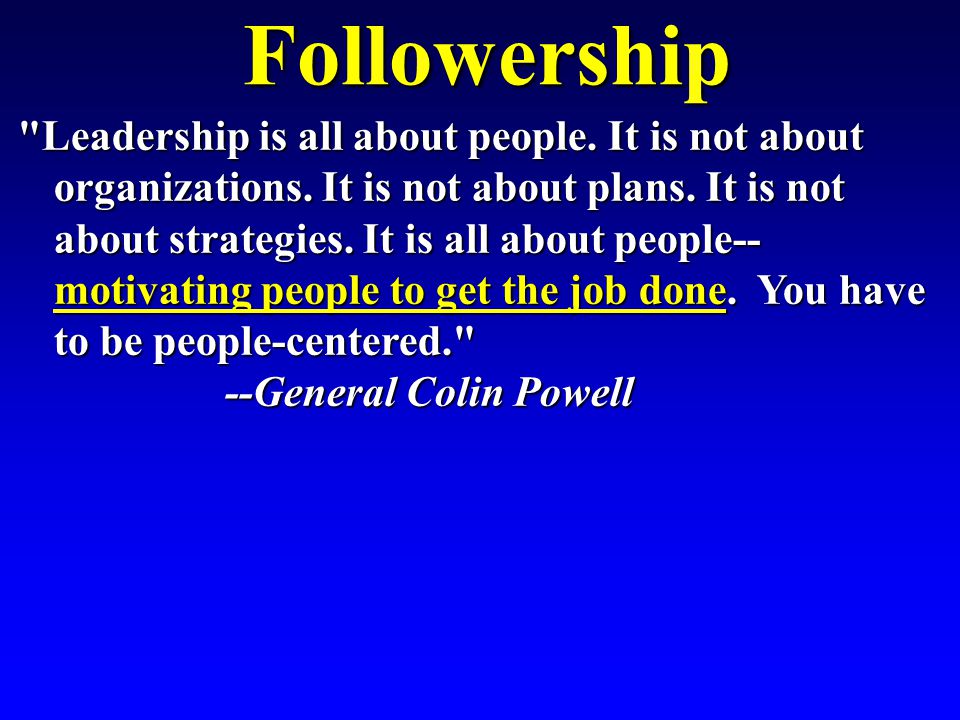Followership is the actions of someone in a subordinate role. It can also be considered as a specific set of skills that complement, a role within a organization, a social construct that is integral to the leadership process, or the behaviors engaged in while interacting with leaders in an effort to meet organizational objectives. As such, followership is best defined as an intentional practice on the part of the subordinate to enhance the synergetic interchange between the follower and the leader. In organizations, “leadership is not just done by the leader, and followership is not just done by followers.” This perspective suggests that leadership and followership do not operate on one continuum, with one decreasing while the other increases.
The Power of Followership by Robert Kelley starting at $24.97. The Power of Followership has 1 available editions to buy at Alibris. Download lagu yg liriknya ditaman yg sepi menanti dirimu kembali.
Rather, each dimension exists as a discrete dimension, albeit with some shared competencies. The study of followership is an emerging area within the leadership field that helps explain outcomes. Specifically, followers play important individual, relational, and collective roles in organizational failures and successes.

“If leaders are to be credited with setting the vision for the department or organization and inspiring followers to action, then followers need to be credited with the work that is required to make the vision a reality.” The term follower can be used as a personality type, as a position in a hierarchy, as a role, or as a set of traits and behaviors. Studies of followership have produced various theories including trait, behavioral attributes, role, and theories in addition to exploring myths or misunderstandings about followership. • ^ Uhl-Bien, M.; Riggio, R.; Lowe, K.; Carsten, M.
'Followership theory: A review and research agenda'. The Leadership Quarterly. 'Followership research: looking back and looking forward'. Journal of Leadership Education. Special (4): 15–19. • Favara, F.L.
• Baker, S.D. 'Followership: The theoretical foundation of a contemporary construct'. Journal of Leadership & Organizational Studies.
• ^ Kelley, R.E. 'In praise of followers'. Harvard Business Review. All in “the family”: Leading and following through individual, relational, and collective mindsets. Carsten, & M.

Hurwitz (Eds). Followership in action: Cases and commentaries (pp. Bingley, England: Emerald.
• Carsten, M.; Harms, P.; Uhl-Bien, M. 'Exploring Historical Perspectives of Followership: The Need for an Expanded View of Followers and the Follower Role'. In LaPierre, L.M.; Carsten, M.K. Followership: What is it and why do people follow? Bradford, GBR: Emerald Group Publishing.
• Townsend, P. 'Fitting teamwork into the grand scheme of things'.
The Journal for Quality and Participation. 25 (1): 16–18. • Powell, C, (n.d.) • Thomas, T.; Berg, P.
'Followership: Exercising discretion'. Journal of Leadership Education. Special (4): 21–35. • DiRienzo, S. 'A challenge to nursing: Promoting followers as well as leaders'. Holistic Nursing Practice.
9 (1): 26–30. • Han, Ji-Young; Kim, Mi-Ye (2009). 'The Impact of the Followership Style on the Organizational Effectiveness in Nursing Organization'. Journal of Korean Academy of Nursing Administration. 15 (2, ): 233–243. • Kouzes,, J.; Posner, B. The leadership challenge (5th ed.).
San Francisco, CA: Jossey-Bass. • Jackson, B.; Parry, K. A very short, fairly interesting and reasonably cheap book about studying leadership (2nd ed.). London, UK: SAGE Publications, Ltd. • ^ Hurwitz, M.; Hurwitz, S. Leadership is half the story: A fresh look at followership, leadership, and collaboration.
Toronto, ON: University of Toronto Press 2015 Rotman-UTP Publishing. • Hurwitz, M.
'Followership: A Classroom Exercise to Introduce the Concept'. Management Teaching Review: 71746. • Kleiner, K.
'Rethinking leadership and followership: A student's perspective'. In Riggio, R.; Chaleff, I.; Lipman-Blumen, J.
The art of followership: How great followers create great leaders and organizations. San Francisco, CA: Jossey-Bass – A Wiley Imprint. • Owen, J (2016). Introducing Followership to Enhance the Booster Juice Franchisor/Franchise Partner Relationship. (Organizational Leadership Project) Royal Roads University. Victoria, Canada • Bell, D.
Followers' preferences for leaders behavioral characteristics: A case study of franchise restaurants. Available from ProQuest Dissertations & Theses Global. • Wildflower,L., & Brennan, D. The handbook of knowledge-based coaching: What we really do when we coach. Retrieved from • Whiteside, S. Impact of executive coaching on small businesses and franchisees. Available from ProQuest Dissertations & Theses Global.
• ^ Deale, Cynthia S.; Schoffstall, Donald G.; Brown, Eric A. 'What does it mean to follow? An exploration of a followership profile in hospitality and tourism'.